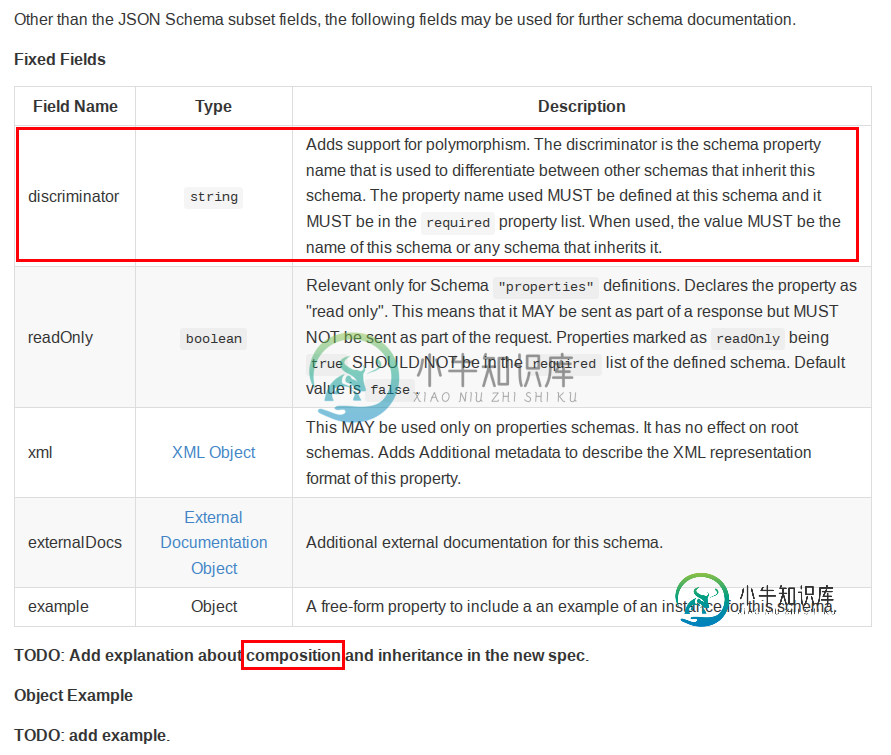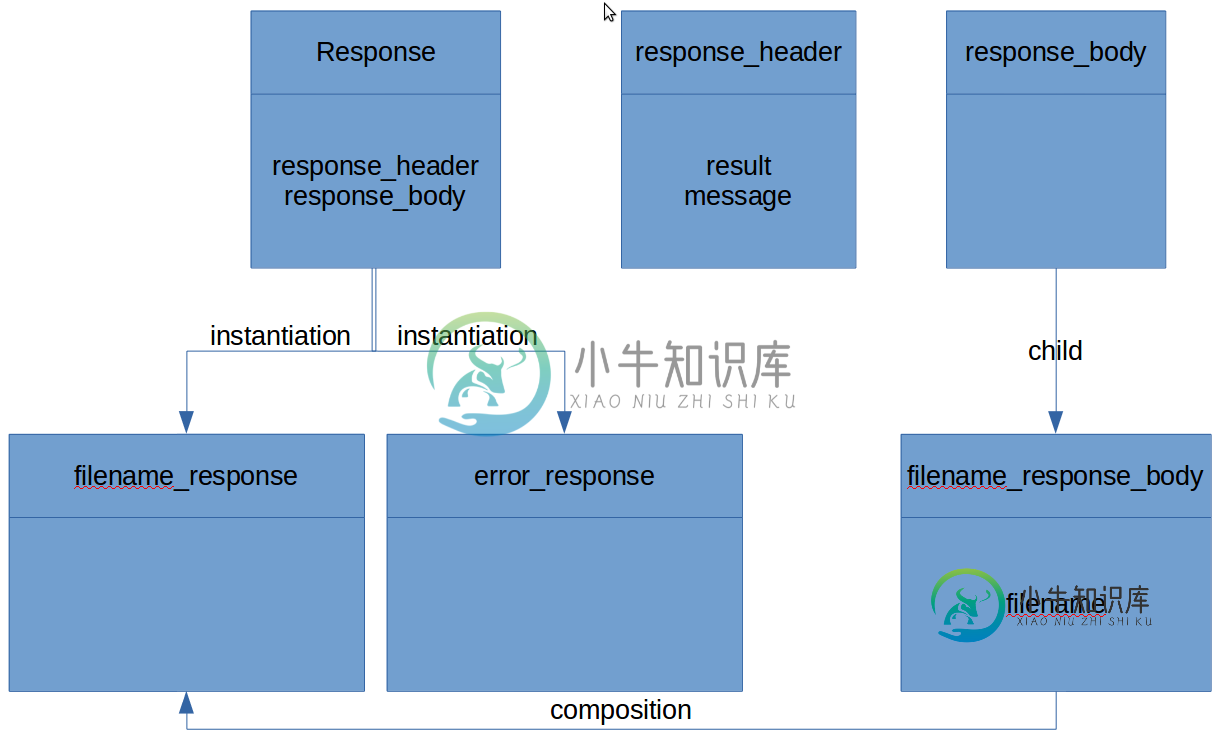虚张声势的继承与创作
在我的“简化”API中,所有响应都是从基本“响应”类派生(继承)的。响应类由一个填充元数据的头和一个包含用户请求的核心数据的主体组成。响应(在JSON中)的布局使得所有元数据都在第一个“层”上,而主体是一个称为“主体”的单一属性
response
|--metadata attribute 1 (string/int/object)
|--metadata attribute 2 (string/int/object)
|--body (object)
|--body attribute 1 (string/int/object)
|--body attribute 2 (string/int/object)
我试图用以下JSON来定义这种关系:
{
...
"definitions": {
"response": {
"allOf": [
{
"$ref": "#/definitions/response_header"
},
{
"properties": {
"body": {
"description": "The body of the response (not metadata)",
"schema": {
"$ref": "#/definitions/response_body"
}
}
}
}
]
},
"response_header": {
"type": "object",
"required": [
"result"
],
"properties": {
"result": {
"type": "string",
"description": "value of 'success', for a successful response, or 'error' if there is an error",
"enum": [
"error",
"success"
]
},
"message": {
"type": "string",
"description": "A suitable error message if something went wrong."
}
}
},
"response_body": {
"type": "object"
}
}
}
然后,我尝试通过创建从body/header继承的各种body/header类来创建不同的响应,然后创建由相关的header/body类组成的子响应类(如底部的源代码所示)。然而,我的实现方式肯定是错误的。我在swagger 2.0规范(如下所示)中找不到继承的例子,但找到了组合的例子。

我很确定这个“鉴别器”有很大的作用,但不确定我需要做什么。
有人能告诉我如何在swagger 2.0(JSON)中实现组合继承吗?最好是通过“修复”下面的示例代码。如果我可以指定一个从response继承的ErrorResponse类,其中头中的“result”属性总是设置为“error”,那也太好了。
{
"swagger": "2.0",
"info": {
"title": "Test API",
"description": "Request data from the system.",
"version": "1.0.0"
},
"host": "xxx.xxx.com",
"schemes": [
"https"
],
"basePath": "/",
"produces": [
"application/json"
],
"paths": {
"/request_filename": {
"post": {
"summary": "Request Filename",
"description": "Generates an appropriate filename for a given data request.",
"responses": {
"200": {
"description": "A JSON response with the generated filename",
"schema": {
"$ref": "#/definitions/filename_response"
}
}
}
}
}
},
"definitions": {
"response": {
"allOf": [
{
"$ref": "#/definitions/response_header"
},
{
"properties": {
"body": {
"description": "The body of the response (not metadata)",
"schema": {
"$ref": "#/definitions/response_body"
}
}
}
}
]
},
"response_header": {
"type": "object",
"required": [
"result"
],
"properties": {
"result": {
"type": "string",
"description": "value of 'success', for a successful response, or 'error' if there is an error",
"enum": [
"error",
"success"
]
},
"message": {
"type": "string",
"description": "A suitable error message if something went wrong."
}
}
},
"response_body": {
"type": "object"
},
"filename_response": {
"extends": "response",
"allOf": [
{
"$ref": "#definitions/response_header"
},
{
"properties": {
"body": {
"schema": {
"$ref": "#definitions/filename_response_body"
}
}
}
}
]
},
"filename_response_body": {
"extends": "#/definitions/response_body",
"properties": {
"filename": {
"type": "string",
"description": "The automatically generated filename"
}
}
}
}
}
为了尝试澄清我想要的内容,我创建了下面非常基本的图表,旨在显示所有响应都是“响应”对象的实例化,这些对象是由(组合)使用响应头和响应体对象的任意组合构建的。response_header和response_body对象可以扩展并插入到任何response对象中,这是在filename_response使用基本response_body类的filename_response_body子类的情况下完成的。错误和成功响应都使用“response”对象。

共有3个答案
这里的所有答案都已经很好了,但是我只想补充一点关于组合和继承的小注意。根据Swagger/OpenAPI规范,要实现组合,使用allOf属性就足够了,正如@oblalex正确指出的那样。但是,要实现继承,您需要将allOf与鉴别器一起使用,如@TomaszSétkowski的示例所示。
此外,我在API Handyman中找到了更多关于组合和继承的Swagger示例。它们是Arnaud Lauret的优秀Swagger/OpenAPI教程系列的一部分,我认为每个人都应该看看。
我发现,即使没有鉴别器的定义,合成也能正常工作。
例如,baseResponse:
definitions:
Response:
description: Default API response
properties:
status:
description: Response status `success` or `error`
type: string
enum: ["success", "error"]
error_details:
description: Exception message if called
type: ["string", "object", "null"]
error_message:
description: Human readable error message
type: ["string", "null"]
result:
description: Result body
type: ["object", "null"]
timestamp:
description: UTC timestamp in ISO 8601 format
type: string
required:
- status
- timestamp
- error_details
- error_message
- result
呈现为:
我们可以扩展它来细化结果字段的自定义模式:
FooServiceResponse:
description: Response for Foo service
allOf:
- $ref: '#/definitions/Response'
- properties:
result:
type: object
properties:
foo_field:
type: integer
format: int32
bar_field:
type: string
required:
- result
它将正确地呈现为:
请注意,allOf足以工作,并且不使用鉴别器字段。这很好,因为它可以工作,这很重要,正如我认为的,工具将能够在没有鉴别器字段的情况下生成代码。
作为一个招摇过市的初学者,我不觉得有关polimorphism和composition的官方文档很容易理解,因为它缺少一个例子。当我在网上搜索时,有很多很好的例子提到了当extends有效时的swagger 1.2。
对于swagger 2.0,我通过这个google小组在github上的swagger规范源代码中找到了一个很好的例子
基于以上来源,下面是YAML中的一个简短有效继承示例:
definitions:
Pet:
discriminator: petType
required:
- name
- petType # required for inheritance to work
properties:
name:
type: string
petType:
type: string
Cat:
allOf:
- $ref: '#/definitions/Pet' # Cat has all properties of a Pet
- properties: # extra properties only for cats
huntingSkill:
type: string
default: lazy
enum:
- lazy
- aggressive
Dog:
allOf:
- $ref: '#/definitions/Pet' # Dog has all properties of a Pet
- properties: # extra properties only for dogs
packSize:
description: The size of the pack the dog is from
type: integer
-
null 另外,作为API开发人员,如果我不使用它,我会失去什么?
-
我正在ASP中使用Swashback 5。NET webapi项目,具有所有默认设置。它序列化方法的输出,以便向我显示应答的模式。我得到的文档如下所示: 这是由以下C#代码生成的 结果在哪里。结果基本上是一个标准的对象列表,每个对象都包含这些键/值/id字段。我在这里读过https://conficient.wordpress.com/2014/05/22/getting-rid-of-k__ba
-
我的中有以下操作。NET核心2控制器。它是一个API,应该存储作为应用程序/x-www-form-urlencoded发布的所有数据 所以斯瓦格UI允许使用UI尝试这个动作:斯瓦格UI 但是SwaggerUI生成带有正文的POST:formData=field 1=value e1&field 2=value e2 我希望它是:field1=value1 所以问题是,这是OpenAPI的限制,还是
-
我正在为我的spring boot项目使用swagger注释。 我想为控制器的每个资源返回一个公共响应代码契约。 在文件中:https://github.com/swagger-api/swagger-core/wiki/annotations#apiresponses-apiresponse他们谈论@ApiResponses,但我不能将注释放在类级别。 以下是我所做的: 但问题是和中的坏东西从未
-
本文向大家介绍C++多重继承与虚继承分析,包括了C++多重继承与虚继承分析的使用技巧和注意事项,需要的朋友参考一下 本文以实例形式较为全面的讲述了C++的多重继承与虚继承,是大家深入学习C++面向对象程序设计所必须要掌握的知识点,具体内容如下: 一、多重继承 我们知道,在单继承中,派生类的对象中包含了基类部分 和 派生类自定义部分。同样的,在多重继承(multiple inheritance)关系
-
我想使用Swashuckle(swagger for. net)在WebAPI项目上进行基于API密钥的身份验证。 我已经配置了如下虚张声势: (见 https://github.com/domaindrivendev/Swashbuckle#describing-securityauthorization-schemes) 它似乎创建了我所期望的swagger文件: 但是当我进入UI并‘尝试’时

